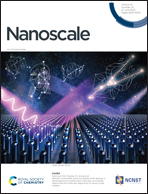Interface and electronic structure engineering induced Prussian blue analogues with ultra-stable capability for aqueous NH4+ storage†
Abstract
Aqueous ammonium ion batteries (AAIBs) are considered potential energy storage solutions due to their faster kinetics, eco-friendliness, and high safety. Yet, appropriate electrode material for AAIBs is in continual investigation. Here, Prussian blue analogues (PBAs), Na0.73Ni[Fe(CN)6]0.88, are applied by a covalent bond assisted engineering with in situ polyaniline (PANI) polymerization. The synthesized PANI/Na0.73Ni[Fe(CN)6]0.88 hybrid (PNFF) inherited the advantages of the high conductivity of PANI and the stability of PBAs. The content of PANI had an effect on the electrochemical performance of PNFF. When served as cathode for AAIBs, the as-prepared PNFF-60 (PNFF with adjusted PANI content) delivers an enhanced reversible capacity of 92.5 mA h g−1 at 100 mA g−1 after 200 cycles. Even at a high current density of 2000 mA g−1, 95.2% capacity retention (1000 cycles) can be achieved by PNFF-60. The ammonium storage mechanism of PNFF-60 is fully investigated by in situ Raman and ex situ XPS/FTIR analysis. Moreover, an aqueous NH4+ full cell is assembled by coupling the polyimide@MXene (PI@MXene) anode, exhibiting durable cycling stability. This work adds to the understanding of constructing PBAs-based hybrid electrodes for ammonium ion storage devices.



 Please wait while we load your content...
Please wait while we load your content...